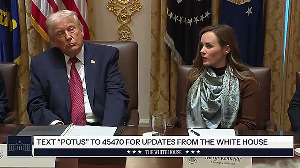IDS-2 and raids to uncover black money stash keep receipts flowing, report Arup Roychoudhury and Sanjeeb Mukherjee.
Illustration: Dominic Xavier/Rediff.com
 Even as the cash crunch following demonetisation hit advance tax collections for the quarter ending December, economists say the fiscal deficit target of 3.5% of gross domestic product (GDP) for this financial year (FY17) is not a difficult one.
Even as the cash crunch following demonetisation hit advance tax collections for the quarter ending December, economists say the fiscal deficit target of 3.5% of gross domestic product (GDP) for this financial year (FY17) is not a difficult one.
Economists believe the Pradhan Mantri Garib Kalyan Yojana or the income declaration scheme-2 (IDS-2), in popular parlance, and raids on various entities to unearth black money, may offset the shortfall in tax collections.
They are optimistic despite the fact that IDS-1, which was expected to fetch the government Rs 7,500 crore (Rs 75 billion) by November 30, managed only Rs 6,800 crore (Rs 68 billion).
On November 8, Prime Minister Narendra Modi declared the old series of Rs 500 and Rs 1,000 currency notes to be illegal tender.
The resulting cash crunch dented advance tax numbers, with some fast-moving consumer goods companies and banks reporting a year-on-year decline.
Of the top 100 corporate entities in terms of advance tax payments, the figure for 43 is up 10.1% to Rs 27,322 crore (Rs 273.33 billion).
But without Reliance Industries, Bharat Petroleum, Hindustan Petroleum and Indian Oil, the picture would have been grim.
The remaining 39 companies' total tax outgo is up only 3.7%.
Shubhada Rao, chief economist, YES Bank, however, is hopeful. She said people taking advantage of IDS-2 and income-tax officers seizing money through raids would offset the low mop-up.
Indirect taxes have also been hit by demonetisation, but these were camouflaged by higher numbers in the months prior to November, additional revenue measures of the government which included increase in service tax rate from 14.5% to 15% in this financial year.
The government had also raised excise duty on petroleum, but it was done way back in November, December 2014 and January 2015 and was factored in the Budget while making projections.
Collections were up 26.2% to Rs 5.52 lakh crore in the first eight months (April to November) of FY17.
The Budget Estimate was 10.8% growth. But, without additional revenue measures, the rise was just 8%.
"We expect the fiscal deficit target will be met. Indirect tax collections have been good," Rao said.
D K Joshi, chief economist, CRISIL, said expected slower economic activity in January-March, as a result of demonetisation, would affect indirect tax receipts, but it would hardly affect gains in direct tax.
"Though boosting fiscal resources was not an intention of policy makers," Joshi said, "the effect will be a positive one."
Also, as nominal GDP growth shrinks, the absolute number to touch the 3.5% target would be lower. The Budget had assumed nominal growth at 11% (Rs 150.65 lakh crore).
So, the fiscal deficit target would be Rs 5.33 lakh crore.
With demonetisation, lower growth is expected. All indicators, such as index of industrial production (IIP), the purchasing managers' index for services, and -- to lesser extent -- even manufacturing PMI, as well as merchandise export growth point towards that.
Till October, fiscal deficit had touched 79.3% of Budget Estimates (BE). Last year, it was only 74%. This might indicate that the fiscal math has gone awry, but till September, the fiscal deficit target had touched 83.9%.
In October, there was actually a fiscal surplus.
In previous years, indirect taxes and non-tax revenue usually met the direct tax shortfall. This year, the direct tax target might actually be met and not revised downwards.
Two other developments have to be factored in: Spectrum sale and divestment estimates.
The spectrum sale target was Rs 64,000 crore (Rs 640 billion); from the auctions till now, it seems the government will only get half of it.
The divestment target was Rs 56,500 crore (Rs 565 billion) -- Rs 20,500 crore (Rs 205 billion) from strategic sales; the rest from selling minority stakes and buybacks.
Only the stake sale has delivered Rs 24,000 crore (Rs 240 billion) till end-October.
In non-tax revenue, the Centre will depend on dividends from public sector units (PSUs), banks and the Reserve Bank of India.
The PSU dividend target is Rs 53,883 crore (Rs 538.83 billion) -- 22% more than last year's revised estimates (RE).
BE of banks' and RBI's dividends is Rs 70,000 crore (Rs 700 billion) -- Rs 4,000 crore (Rs 40 billion) less than RE FY16.
A shortfall will force the Centre to cut spending.
The finance ministry expects Rs 10,000 crore to Rs 20,000 crore (Rs 100 billion to Rs 200 billion) to be returned from the defence capital budget.
But the government has already spent massively on pensions, infrastructure and rural schemes.
The government would have a record Rs 2.47 lakh crore capital expenditure. The Pay Commission award and higher military pensions, even with deferred allowance, means an additional Rs 85,000 crore (Rs 850 billion) outgo.
For the Mahatma Gandhi National Rural Employment Guarantee Act, the outgo could be as high as Rs 47,000 crore (Rs 470 billion) -- the highest ever.
With the government trying to take advantage of a good monsoon after two back-to-back droughts, the outgo for other rural schemes has also shot up.
Subsidies would also affect the fiscal math.
The government allocated Rs 135,000 crore in FY17.
Till the first quarter, Rs 26,000 crore (Rs 260 billion) has been released. Officials claims it could touch Rs 140,000 crore.
It could also be more if the government decides to dip into the National Small Savings Fund (NSSF).
For this the Food Corporation of India would have an additional interest burden of Rs 9,000 crore (Rs 90 billion).
The NSSF corpus could be lowered by Rs 45,000 crore (Rs 450 billion) to clear FCI dues (Rs 50,000 crore/Rs 500 billion)) over five years, starting 2016-2017.
The BE of oil subsidy is Rs 26,000 crore (Rs 260 billion).
Experts claim it might not exceed the BE by much as oil prices have been mostly down.
The fertiliser minister has already placed a demand for an extra Rs 25,000 crore (Rs 250 billion) against BE of Rs 75,000 crore (Rs 750 billion) -- to pay dues -- which has been exhausted by August.
Unpaid dues might touch Rs 40,000 crore (Rs 400 billion) -- but slightly lower than last year, thanks to lower gas prices.
Extra subsidies could be carried forward to the next year keeping the fiscal math intact.
But the Centre's books would continue to be burdened.











